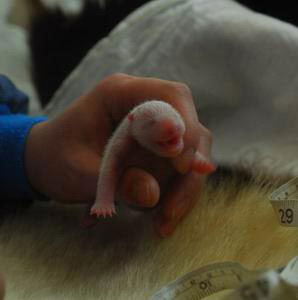| Home / Environment / News | Tools: Save | Print | E-mail | Most Read |
| Year's First Panda Cub Born, Doing Well: Wolong Center |
| Adjust font size: |
Scientists with the China Panda Protection and
The cub, female and born to a 13-year-old giant panda named Ji Ni, has gained seven grams since its birth on Friday, and is being cared by breeders at the center's nursery, said Zhou Xiaoping, deputy director of the Wolong center.
The 13.3-cm-long baby panda only weighed 90.2 grams at birth after an extremely long gestation of 324 days, almost four times the normal gestation period. Experts say the birth created three new records. It is the first panda cub to be born so early in the new year; Ji Ni is the oldest panda to deliver a first cub and she had the longest recorded pregnancy. Shortly after birth, Ji Ni had difficulty nursing the cub on her own. She appeared weak and tense as it was the first time for the mother to give birth, said Zhang Hemin, director of the center. To guarantee the safety of the cub, researchers at the center took the cub away from its mother to keep it in nursery, Zhang said. Both Ji Ni and her female cub are doing fine, Zhang added. Ji Ni, born at Beijing Zoo in 1993, had been inseminated several times but never gave birth before it was sent to the Wolong center in January 2006. Panda specialists say female pandas kept in captivity can have a gestation that can last from 80 to 183 days. They usually enter into oestrum in spring and give birth in autumn. Last year, 19 pandas were produced in the Giant pandas, only found in Currently, over 200 pandas are being kept in captivity, over half of which are living at the Wolong center. (Xinhua News Agency February 26, 2007) |
| Tools: Save | Print | E-mail | Most Read |
 |
| Related Stories |
|
|||
